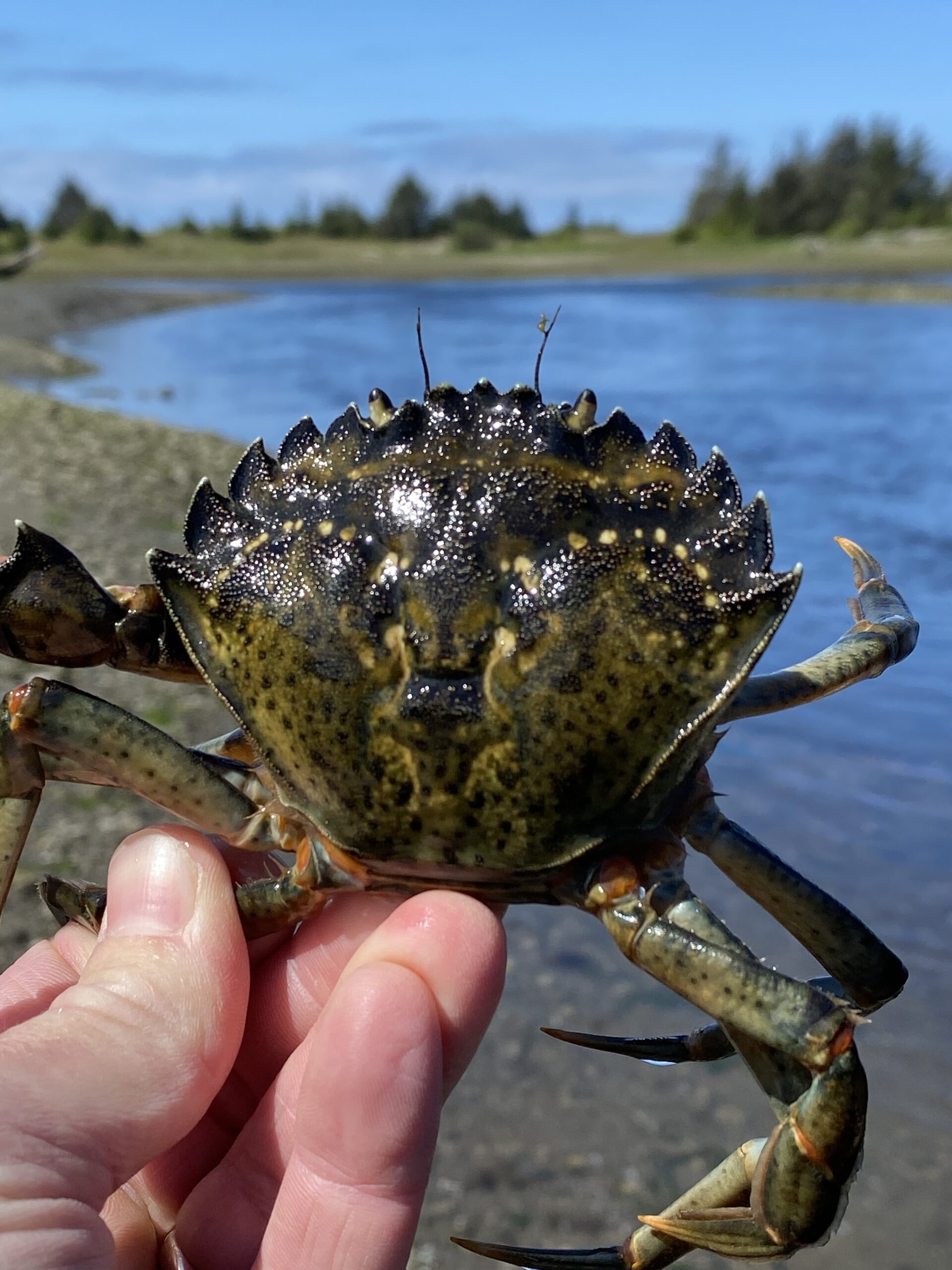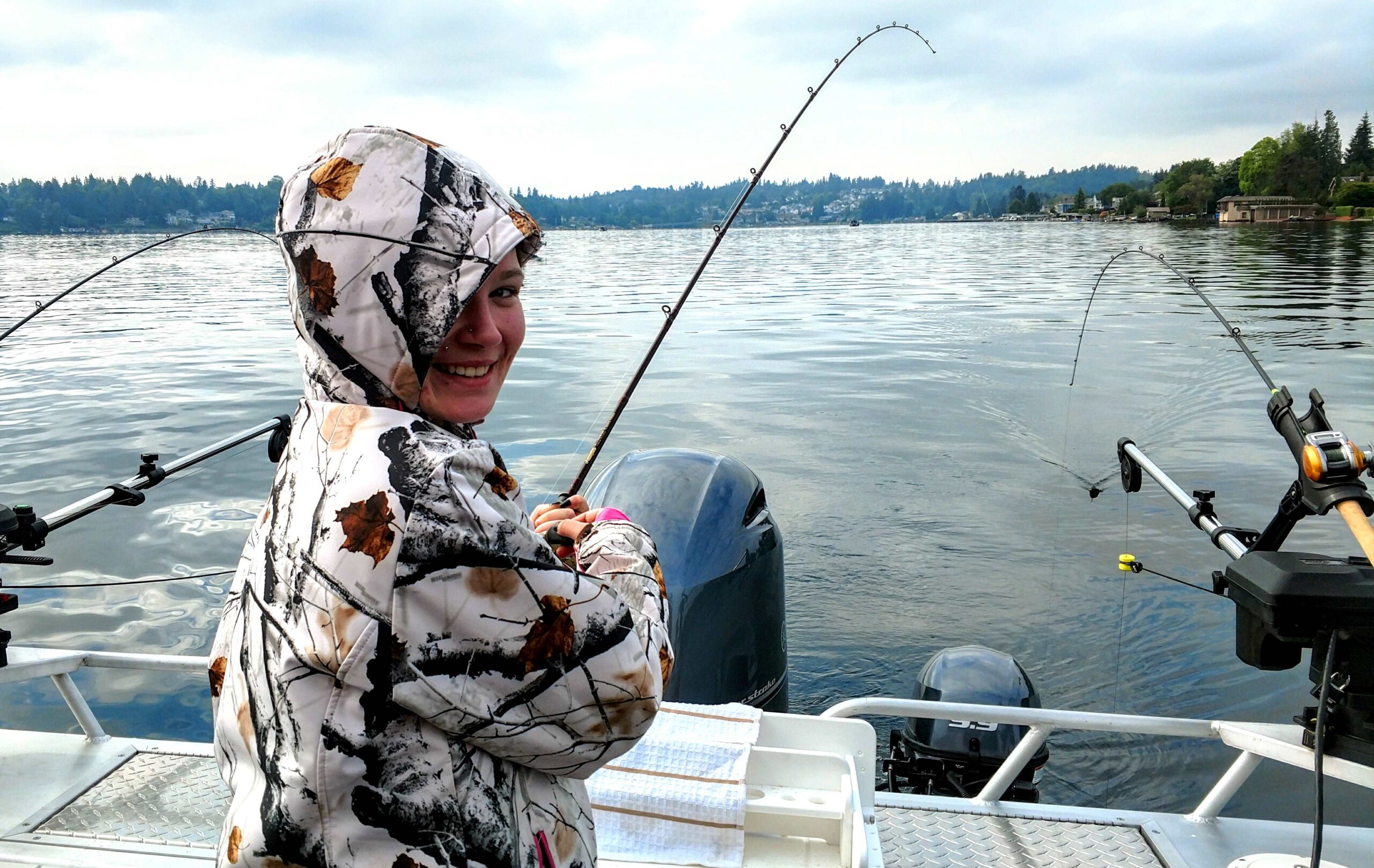While I know that our local lingcod fishery closes June 15th hopefully this will be available for the last few days of the 2023 lingcod season. If not, it will give you a head start on next year’s lingcod plans. With the exception of the Marine Area 12 (Hood Canal) lingcod closure, Washington State WDFW Marine Areas 5-Marine Area 13 are open for lingcod fishing from May 1st through June 15th. It’s a short fishery managed with a slot limit. You can only retain 1 fish that is 26-36” long each day. With the slot limit, legal fish are hard to come by after the opener. Lingcod is excellent table fare with many preparation options. Sooo, what the heck is a lingcod?
Lingcod or Ophiodon Elongatus. They are not actual cod, but a species of greenling. Lingcod are eating machines and can weigh over 80 pounds and tape out at 60” long. They have a 5-gallon bucket for a mouth with 18 needlepoint teeth to make sure their intended meal stays put (handling, never put your hand or fingers in their mouth or try to pick one up via hand in the gills). They are a very cool-looking warrior of the depths. Their color varies but all have clusters of darker colored and copper-colored patches.
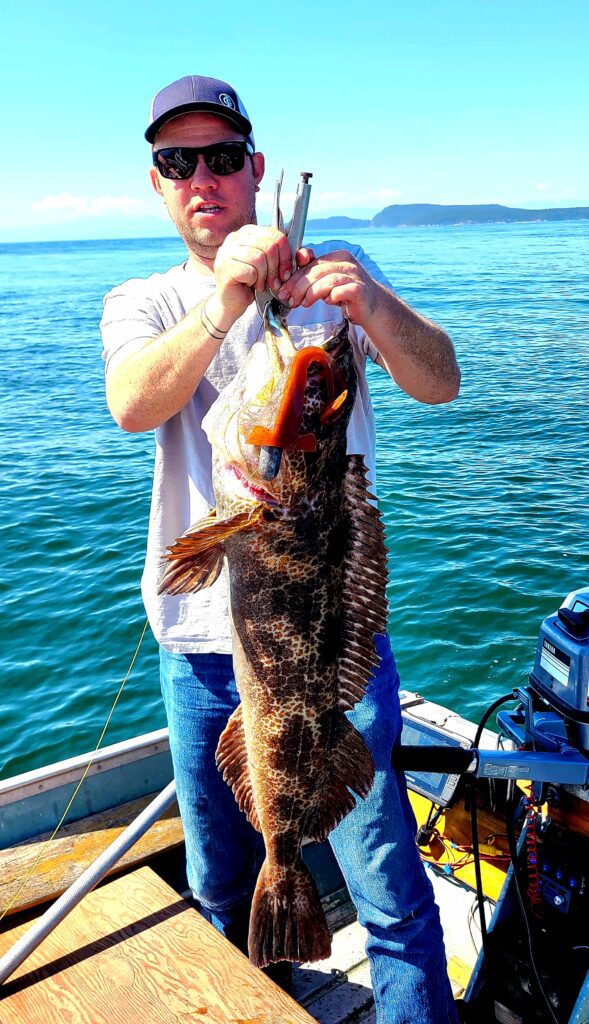
Unlike humans, male lingcod mature at around 2 years old and 20”. The female lingcod mature at 3-5 years and 24-30”. Us mortals are just the opposite; females mature earlier than men and like myself, some of us never mature beyond 12 or so. Initially, both male and female lingcod have similar growth rates and grow very quickly. At around 4 years old the female lingcod growth rate outpaces the males.
Lingcod spawn December-March along reefs and rock outcroppings during periods of strong tidal flows and wave action. The eggs are deposited and fertilized in nests in crevasses in the rock. After spawning the males protect the nests until they hatch in 5-11 weeks.
Lingcod are very vulnerable while the eggs are developing. The males are very aggressive and will attack anything considered a threat to the nest. Many become prey while guarding the nests, leaving the nest vulnerable to predators. An unprotected nest is usually decimated in a day or so. The male lingcod is essential for successful spawning.
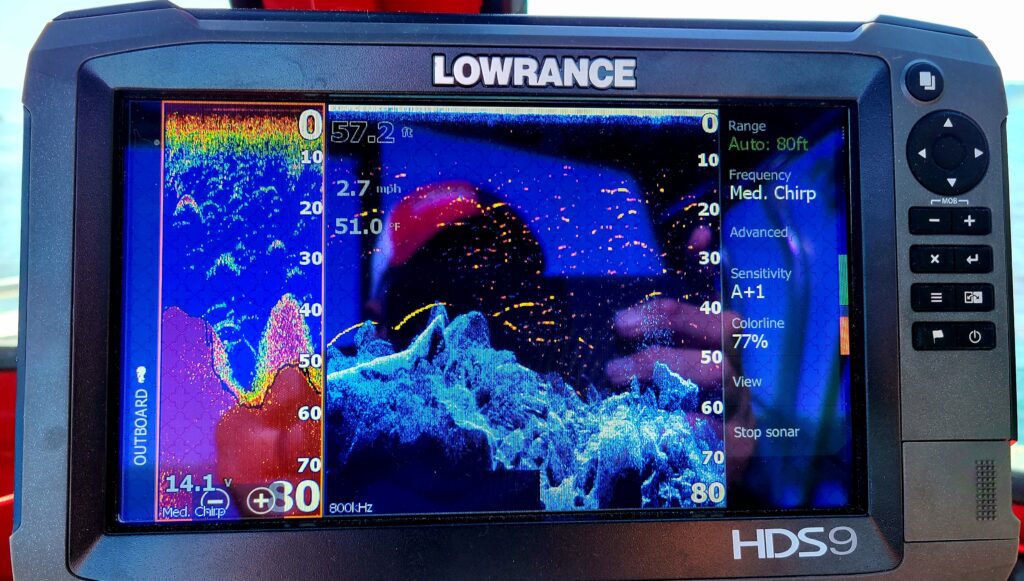
Although some migration has been observed, generally lingcod stay in the same location most of their lives. They are typically structure-oriented and found in 30-300 feet of water. However on Mother’s Day a few years back I caught a lingcod while flyfishing from the beach (not as bad as it sounds. I was doing a big brunch on a beach and had everything set up and ready to go. Planned or otherwise I had some time before everyone arrived. I know, I know; I still had a rod and gear with me on Mother’s Day…)
Fishing for lingcod in the straights, the San Juans, and inner Puget Sound can be a very rewarding adventure. Partially because once you find your rockpile it can hold fish for years. Lingcod can be found along any surface visible structure and here locally lingcod opportunity abounds. I like to meter around to find isolated rockpiles and then mark them on my electronics (note to self, don’t try to declutter your chart while not paying attention to what you’re doing. Just recently I deleted most of my spots accidentally. I think that I was in tears…) Having a secrete rockpile can make you a lingcod Zen Master, The Ling Whisperer!
Once you have figured out where to fish, now what? Lingcod fishing can be either a put-the-rod-in-a-holder passive affair or a highly technical means of working an artificial bait along the edge of a reef. My approach is somewhere in the middle. Typically, I actively fish artificial baits using a less aggressive drop-and-retrieve method. More on that later…
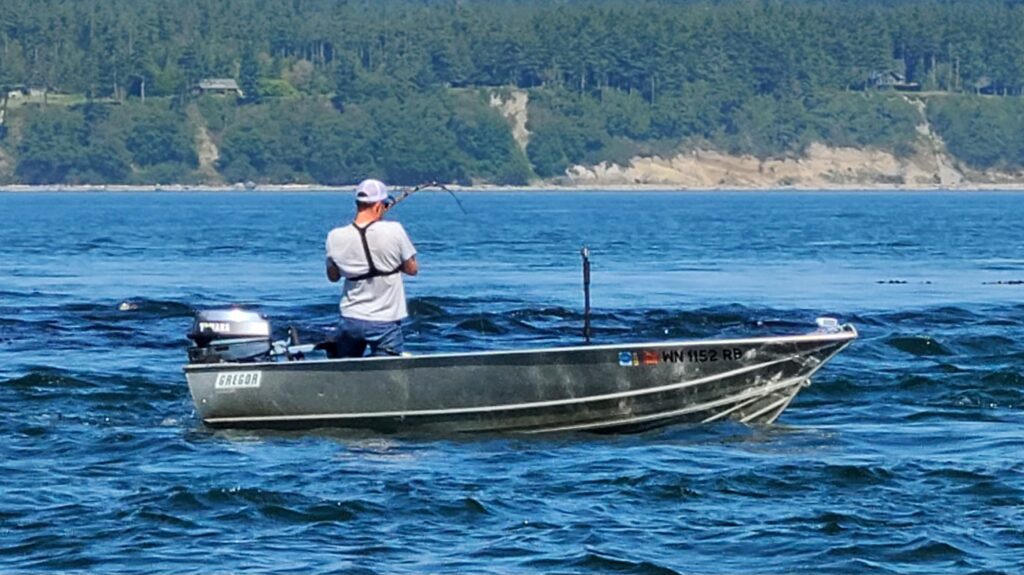
Bait or artificials? Both work and lingcod are suckers for just about anything that passes in front of them. One of the biggest lings I have ever caught was a massive beast that had latched on to a smaller ling that had inhaled a homemade copper pipe jig. That said; bait can be deadly here in Puget Sound. Although herring or squid work sanddabs are the way to go.
Sanddabs are easy to find, catch, and work well dead or alive. A simple way to keep them mostly alive is to keep them in a salt brine in a cooler. A couple of bags of ice, salt water, and an extra cup of rock salt. Not always but it seems that when you take the sanddabs out of the brine, they perk up a bit. It may be a suspended animation thing, like an old horror movie “The Attack of the Killer Sanddabs”…
I like to fish sanddabs on a 2-6 ounce painted jig head and fish them like an artificial bait. They also fish well on a dropper loop rig or a hard tie heavier mooching rig. If fishing them on the mooching rig, hook the lead hook through the mouth, out through the lower jaw then about 2/3rds of the way down the sanddab’s body the trailing hook just under the skin on the dark side of the fish. Insert the hook, point towards the tail, and loop it back out letting it just dangle along the back of the sanddab. Keep a solid hand on the rod. When a lingcod sets its sights on having a sanddab snack, the takedown can be ferocious.
My favorite way to fish lings is with a large curly tail or paddle-tail type swimbait on a jig head but any artificial bait works. I have caught lings using pipe jigs, flutter jigs, and a variety of commercially molded baits, including molded sanddabs. Fished correctly the artificials drive lingcod nuts. The picture of the big ling was caught in Rosario Strait by James Vermeer using a home-poured bait.
Actually, a great story; he used a kid’s toy plastic shark to create a mold and then poured the lure. After a few testing modifications, he ended up with a heavy-bodied lure that was balanced in the water and sent out all kinds of “come-eat-me” vibrations. More importantly, James knows how to fish lings.
I was motoring past in the workboat and noticed a guy in a small skiff fishing lingcod. I pulled the throttle back and watched the show. He clearly knew how to properly fish lings on artificial baits. Not long after I stop, he goes bendo and had on what looked to be a serious lingcod. 10 minutes later he and the fish were posing for a picture or two.
”Properly fish lings on artificial baits”, what the heck am I talking about? Let’s break artificial baits down into 3 categories; pipe jigs, dart type jigs, and soft baits. They each fish a little differently
Pipe jigs should be fished straight up and down in deeper water. (Unless you are fishing for lings in WDFW Marine Area 4 East-Marine Area 11 and Marine Area 13 where fishing for bottomfish is prohibited in water deeper than 120’). Meter around and find a deeper reef. Either anchor or set up a drift along the side of the reef or from the high point towards deeper water. It doesn’t hurt to do a couple of test drifts with your chart trails on to see how you’re drifting. Once on station let your pipe jigs fall to the bottom (it helps to make sure they are attached to your line), touch bottom, and then wind up a few cranks. Basically, you want to fish just off the bottom while occasionally bouncing the jig off the bottom. Don’t erratically jerk your rod tip up and down. For lings, you want a slow deliberate motion. If you go herky-jerky you just attract rockfish.
When fishing dart type or flutter jigs think salmon. Free spool to the bottom of your intended meter mark and stop. Slowly lift your rod tip about a foot and then quickly drop it again. The bite will almost always be as the jig is fluttering down. That said; I have caught a few lings casting and retrieving a Point Wilson Dart. One of my biggest San Juan lings chased down and inhaled a jig right at the boat up at Point Lowrance in the San Juans.
Fishing soft baits is my favorite way to catch lingcod. There is something addictive about the takedown when you are actively working on an artificial bait for lings. My routine is to position the boat then drop your offering via free spool until it hits bottom and reel up a crank or 2. Then kind of become one with the rod and allow the current to work the bait. Slowly lifting the rod tip or letting out line here and there to avoid snagging the bottom while keeping in the zone.
Lingcod are pretty hardy fish but still be respectful and quickly release any fish not going in for a ride in your fish box. To preserve the table quality, make sure to break a gill raker with dikes or pliers and/or make an undercut at the base of its tail to bleed the fish. Lingcod freeze very well when vacuum bagged and is great for a quick healthy meal.
Start planning for next year’s Month of Ling. Take some time learning to catch sanddabs and study a chart for your select area. Look for underwater rockpiles, structures, or hard ledges and mark them to explore next season. Stock up on gear well before the May 1st opener and may your fish box be full in 2024.







